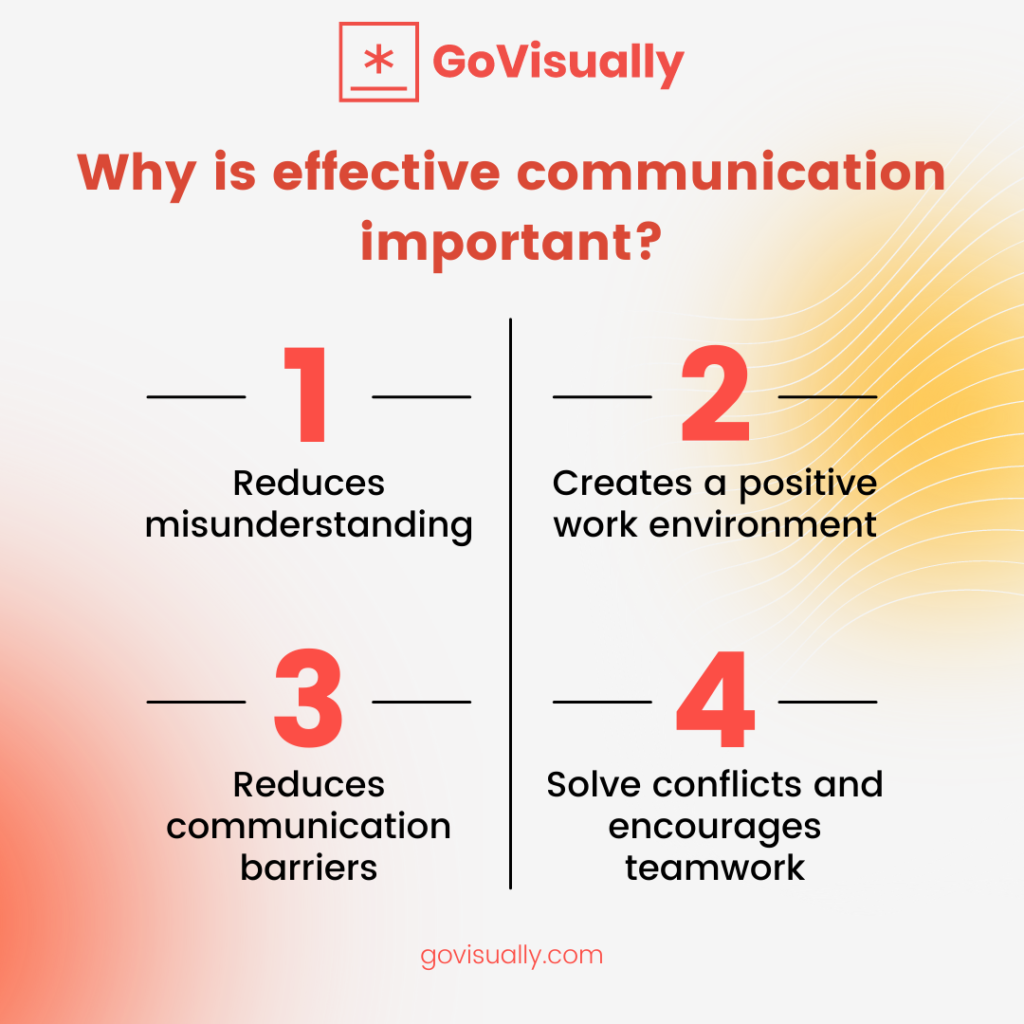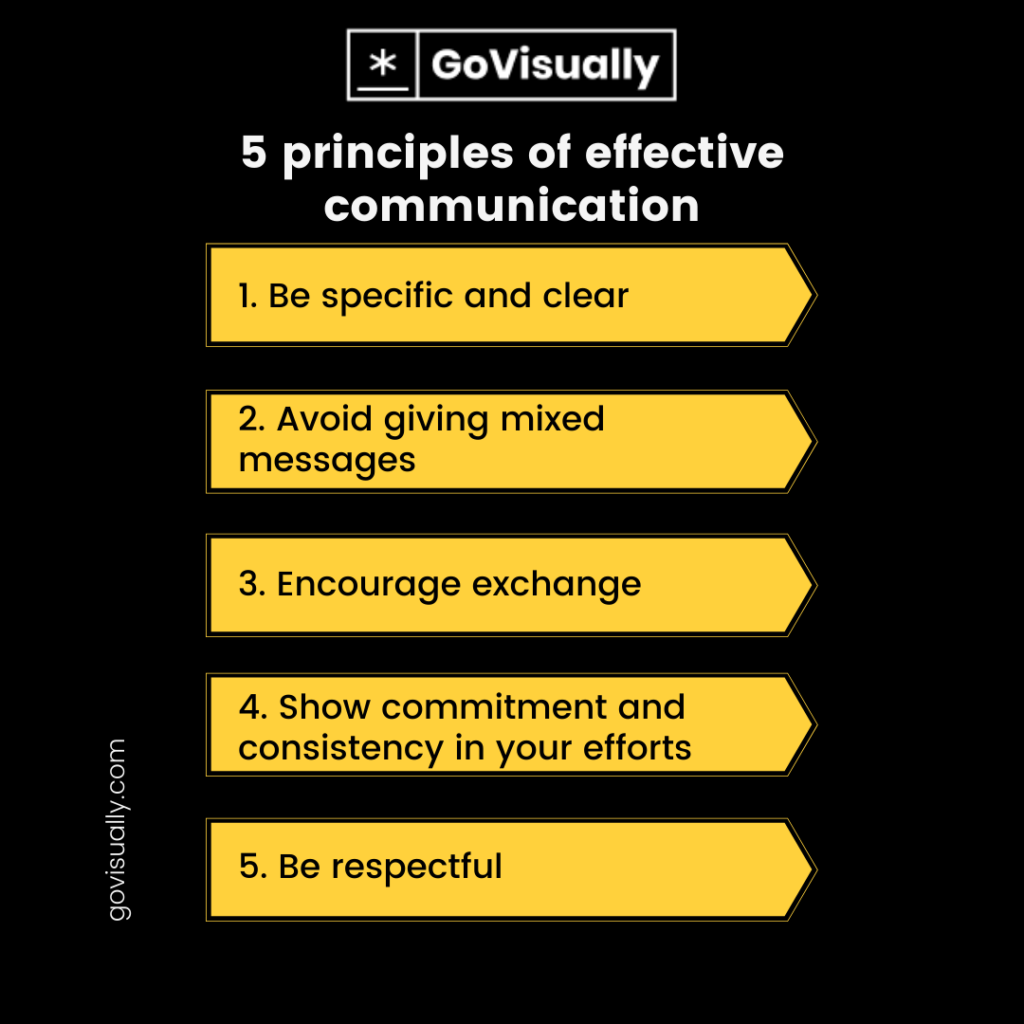Strong and effective communication between coworkers can do wonders for your office workflow.
So, if you are a manager, you must communicate effectively in your work environment. Effective communication can build relationships, minimize errors, and ensure an overall productive workflow.
Ineffective communication can become a major business hurdle and threaten to disrupt your workplace. In fact, in the past years, communication issues alone have cost businesses $37 billion per year.
And that is the worst dream of any business owner coming to life!
So how can you avoid these issues?
Well, the answer lies in becoming an effective communicator among your workforce. Luckily, this guide will give you the best methods to ensure a good communication model. You will learn how to remove communication barriers and why it is important to do so.
So, let’s begin!
Cut design & video review time in half
Try GoVisually free today!
Table of Contents
What is effective communication in the workplace?
Before you implement communication strategies, it is important to understand the effective communication definition that fits best for your workplace.
Communication is a key element of any business, and it is the foundation upon which you grow your company.
Effective communication is conducted between two or more people to successfully deliver, receive, and understand a message. It is the process of information sharing between team members that understand three key components:
- What you want to say
- What you are saying
- And what your audience interprets
These three components make up an effective communication exchange between employees and ensure that your workflow remains productive.
Effective communication in the workplace
In the work environment, effective communication boosts teamwork and leads to better collaborative efforts between employees. Effective communication skills can be used in any industry.
You can use effective communication for individual tasks or collaborate on a project with several members. You can give your managers and employees feedback and assess how your employees are feeling.
Knowing how to communicate is one of the key components of running a successful company. If you don’t have effective communication in the workplace, you risk miscommunication and could even create hostile feelings in your work environment.
You can conduct effective communication in several ways. This can be done in person, in a group meeting, in writing, or on a video conferring platform.

Why is effective communication important?
Effective communication is a necessary part of running a business. Great communication is responsible for a productive workflow and a positive work environment. There are several benefits of effective communication, and here are the top four.

1. Reduces misunderstanding
Effective communication creates less misunderstanding. If you are clear in your conversations, employees understand you better and are quick at taking any action that is required from them.
If there is no misunderstanding in your communication, your workflow is smooth and does not face any interruptions.
2. Helps create a positive work environment
Having effective communication can create a positive environment that fosters creativity. You can create a healthy working relationship with your employees with good communication.
Effective communication is crucial for building trust between management and employees. You create an environment where your team members feel valued and understand that their ideas are being heard.
If you want to relay information to your team, you can do so through effective communication. With this method, you will give out information that is clear and to the point. Clear instructions will make it easy for employees to know what is expected and what steps to take to complete a project.
3. Reduces communication barriers
Effective communication creates a two-way exchange that makes it easier for employees to communicate with you. Employees are more likely to communicate with you if you make them feel welcome and allow open communication channels.
It is important to give feedback and be mindful of your body language to reduce communication barriers.
4. Solve conflicts and encourages teamwork
Communication is important for resolving disputes; therefore, it is important to implement this tool in your workplace. Effective communication makes it easy to solve conflicts as soon as they arise. Great communication can also prevent conflicts by creating a more positive work environment.
Moreover, with effective communication comes great teamwork. Communication makes it easy for team members to stay on track and check in a while working on a project. Good communication is essential for a collaborative process. Effective communication builds trust and rapport between your employees.
5 principles of effective communication in workplaces
Now that you know what effective communication is let’s take a deeper look at the principles of effective communication. If you follow these steps, you will successfully initiate communications in your workplace.

1. Be specific and clear
Always be specific in the message you are trying to convey. When you are specific, it is easier for people to understand and retain information. Concrete information will make it easier for your employees or clients to get the full picture of what you are talking about.
Specific communication should always have data that backs up your information. Your argument should include tools such as data and figures to make it easier to understand. Having factual data back up your communication leaves no room for miscommunication.
Clarity is another key component of effective communication. Whether sending an email or communicating on messaging apps, always be clear in your writing.
When you are talking to someone in person, you can easily clarify your message on the spot. This can be a little harder to do online. Therefore any written communication must be clear and concise. When you are clear in your communication, people will be unable to make their interpretations of your message.
2. Avoid giving mixed messages
Sending mixed messages can drastically ruin effective communication. Your message will lose any effectiveness if it is not coherent.
To have cohesive communication, you need to fully understand the topic you are communicating about. Before talking about it, please familiarize yourself with all the ins and outs of a topic. This will make your message look well-thought-out and logical.
Your message should be sequential, making it easier for people to follow along. Having coherent communication will make it easier for you to capture and maintain people’s attention.
Make sure that your sentences are complete and give full information. Be careful and go over anything you are trying to communicate. By doing consistent checks, you will ensure that your information is complete.
Always make sure that you end your message with a logical conclusion. Your audience should not be left wondering if anything else needs to be said. A complete communication should inform your audience and urge them to take action.
3. Encourage exchange
Effective communication should not be a one-way conversation. A good discourse will make it easier to exchange ideas and information, and it is important for effective communication.
If you want to communicate in the workplace effectively, you need to engage your audience. If you are starting a communication, make sure that you encourage participants of the conversation to engage. This can be done non-verbally as well.
4. Show commitment and consistency in your efforts
Your message show commitment to the subject of your conversation. When you show commitment, you should be dedicated to the topic, fostering effective communication.
Commitment is a great way of building reliability, and it boosts morale in your workplace. Your commitment to your message will help create a bigger impact on people.
If you don’t show your dedication to your message, people are less likely to pay attention to what you are saying, and they are also less likely to follow up on anything you may have asked.
5. Be respectful
A positive environment is crucial for effective communication. Try always to be as honest and polite as possible when communicating in the workplace.
Creating a toxic work environment can drastically harm your business. Using offensive words or speaking rudely can create a hostile work environment. So, it’s important always to be respectful and maintain honesty in your communication.
9 tips on how to effectively communicate with your team and in the workplace
Now that you know the core principles that make up effective communication, here are some ways you can start utilizing this method in your workplace. These practical communication examples will help foster productivity in your workplace while creating a positive environment for your workforce.

1. Always be attentive
Always give your full attention to the person or group you communicate with. Being absent-minded or talking half-heartedly is a sign of miscommunication.
Consider this scenario. You are in a meeting with someone, and they are constantly looking elsewhere or at their phone. You would be disrespected and would immediately lose all interest in the conversation. Therefore, you should always pay your full attention when you are talking to someone or when someone is communicating with you.
One of the biggest ways to show attentiveness is through eye contact. Always be mindful of how you communicate and maintain eye contact when someone addresses you and vice versa.
Always be genuine with your nonverbal reactions, as people can easily tell when your mind is elsewhere. Another nonverbal way of showing attention is by nodding your head. Nod your head affirmatively while communicating to show that you are focused. In short, always pay attention to effective communication.
2. Use a review tool to collaborate and streamline feedback
A lack of proper feedback channels in the workplace can be detrimental to your business. Your workflow can suffer, which can also impact the productivity and morale of your employees.
So, instead of relying on traditional methods of feedback collaboration, switch to an online review tool that can streamline your feedback collection process and make reviewing easier on both ends.
Leverage GoVisually for internal and external review processes
While email is another great communication tool, it can be hard to keep track of conversations or get immediate feedback. Keeping track of your work teams, managers, and clients can be difficult on an email. However, with GoVisually, you can classify projects easily and provide feedback without any hassle.
Suppose you are apprehensive about using an online review and proofing tool for your entire workforce. In that case, you can start by using it for certain projects that require collaboration and immediate feedback. And you’ll see just how quickly it’ll transform your workflow – making it better and saving your team time and resources.
3. Be informative
Effective communication is more than just relaying information. When you communicate with your team, your job is to ensure the information is retained in your audience’s mind. Always make sure to clarify your thoughts and ideas when communicating.
When your message is clear, there is little room for interpretation. To maximize the effectiveness of your communication, always plan. Plan the ideas you want to communicate and back them up with any form of data to create a clear message.
Also, plan the outcome of your message. What do you want people to do after they hear your message. Doing so will make it easy to communicate effectively.
As we’ve mentioned previously, clear and concise communication is the best way to get your message across to people. Do not beat around the bush and always stay on topic.
If you are doing verbal communication or nonverbal communication, always stay on track and don’t give a long speech that strays away from the topic. When you are concise with your conversation, you don’t waste people’s time and can capture their attention without losing it in the middle of your discussion.
4. Be an active listener
Communication is never complete with listening. Listening can sometimes be even more important than talking, and it is an important effective communication skill in the workplace.
Employees who listen and understand your message are much more likely to be productive. When you are listening to someone, don’t be passive. If you actively listen, you will better understand the message. Always be attentive and show an active interest in what a person says.
Here are some ways you can be an active listener:
- Be mindful of your body language.
- Make eye contact during the conversation.
- Do not interrupt the speaker.
- Respond appropriately when asked
5. Find the best communication method for your team
Communication is all about informing and understanding; therefore, the communication tool can either help or ruin your message. There are several methods of communication; try to find the method that works best for your message.
Here are some examples of the types of communication and the method that works best for it:
- Use graphs, images, videos, and charts to illustrate your point clearly for visual communication.
- For verbal communication, you can take face to face with a person or group. You can also communicate on the phone or a video conferencing software.
- Nonverbal communication should be done through eye contact, gestures, body language, and nodding. This shows your focus and attentiveness.
- For written communication, your letters and emails within your workforce. If you want to communicate for advertising purposes, use magazines or the internet.
6. Work on improving your communication skills
Having strong communication skills will make it easier to convey your message effectively. Strong communication skills are beneficial for your professional and personal life. One of the best emotional skills to have is understanding emotional intelligence.
When you are emotionally intelligent, you can understand your and other people’s emotions. Having this skill will do wonders for your communication abilities. Confidence is key, and your message will be highly effective with confidence.
7. Be persuasive
Your manner of communicating is the difference between communication and effective communication. Along with being confident and attentive, you need to be patient and persuasive. These traits are crucial for improving your communication skills.
To apply these qualities to your communication, be mindful of your body language. Your body language can say more than you think. Showcasing positive body language will make it easy to communicate effectively.
Some ways to improve your body language include:
- Maintain a smile and positive demeanor when communicating
- Do not cross your arms when you are talking or listening
- Maintain a correct posture. Don’t be slouchy or lean over the table.
- Maintain eye contact during the conversation
- Keep your devices away and don’t look or use them during the conversation.
8. Employ team-building methods
Team building activities are a great way of fostering effective communication in the workplace. You can give your workforce coffee breaks for them to get to know each other better.
Team bonding will strengthen your communication channels. Coffee breaks can be used as an informal meeting, and it is great at creating a relaxed environment.
You can also host events such as a team lunch, ice breaker games, or outdoor activities to stimulate creativity in your workplace. This type of environment will encourage discussion and generate ideas.
Team building activities will boost employees’ morale and create an ideal working environment.
9. Be appreciative
Showing appreciation to your employees can be a great way of encouraging conversation. Showing appreciation can be a great way of boosting morale and letting your employees know they are valued.
You can show appreciation by:
- Thanking a team member for completing a task
- Giving positive feedback back on a great idea
- Showing gratitude for small tasks
Key takeaway
Effective communication is the key to running a successful business. And the sooner you realize that the earlier you’ll fix your companies’ workflow and productivity levels.
Moreover, online tools like GoVisually can make the process even easier by adopting modern collaboration methods.
So start investing in effective communication today! And do share your thoughts with us on this subject.
Want to send big files?

Need a quick way to share large files and creative assets?
With GoVisually Share, it’s absolutely free! Try today.




